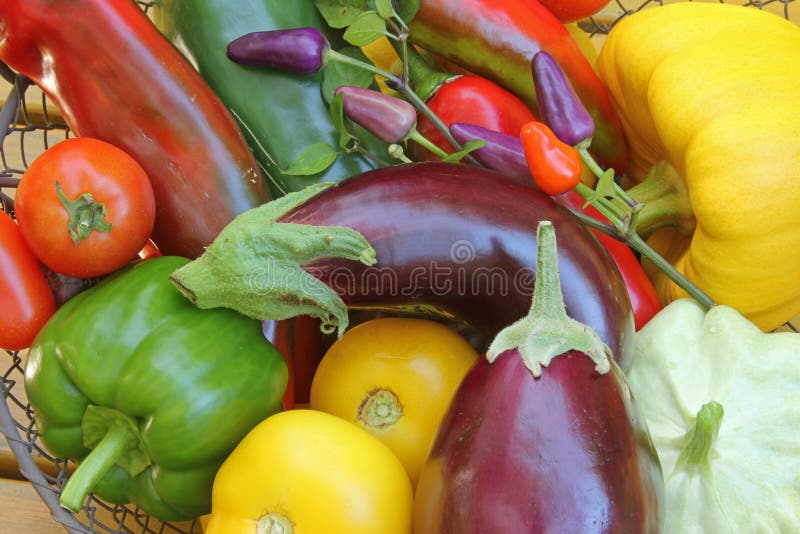OverviewPlantingConditions
Description |
||||||||||||||||||
|
Vegetable grows well in zones 4 and up in full sun with a soil pH between 5.8 and 6.5. If you're fancy, an acidic low nitrogen high phosphorous fertilizer (or just composted manure) worked into the soil will help them grow. They are also heavy users of potassium. That’s why a lot of gardeners recommend adding Epsom salt around tomato and pepper plants–it helps the plant in its uptake of potassium. Lack of nutrients, especially the minerals potassium and calcium, means that the plants will not do well under stress (such as extreme weather, lack of water or uneven watering) and that is the most common cause of blossom end rot. The best way to ensure that your nightshade plants are getting the nutrition they need is to rotate your crops. The nightshades should be planted in the section that was planted in legumes (peas and beans) the year before. Tomatoes: There are two types of tomato plant to choose from: determinate and indeterminate. Determinate plants will grow into .5 to 1m (2-3′) tall bushes and will not require staking. They fruit earlier than vining plants and are better for containers or small spaces. To grow in a container, choose a 51cm (20”) diameter planter at least 12 inches deep. Indeterminate tomatoes will produce large, slicing tomatoes (determinate tomatoes are typically used for sauces or canning) throughout the summer up until the first frost. They will grow into vines that require staking. When transplanting the seedlings, place cages around them or stakes nearby. As they grow, secure the stems to the stakes with twine to hold the plants upright. Some taller bush plants may also benefit from staking if their fruit is on the ground. Indeterminate tomatoes need to be pruned to increase yield and improve flavor. Remove access fruit when they are small and green; varieties that grow large, heavy tomatoes, like beefsteak tomatoes, should only have three tomatoes per branch. Also remove all the leaves below the lowest fruiting branch to increase air circulation and concentrate the plant’s energy on ripening the fruit. And lastly, remove any side shoots sprouting from the juncture between the main vine and a branch. If you want, you can place these shoots in a glass of water, where it will grow roots and become a new plant. Eggplant: Eggplant are also warm season vegetables that need full sun. They need 100 to 150 days to mature, so buying seedlings from a nursery is the way to go. It is possible though to sow seeds 5mm-1cm (¼-½”) deep indoors 8 to 9 weeks before the last frost date. Make sure to keep them warm and the seeds should germinate in 7 to 12 days. Once the nighttime temperatures are reliably above 10°C (50°F), transplant the seedlings into the garden leaving 45-60cm (18-24″) between each plant. It’s a good idea to add compost to the soil before planting to feed the plants and to bring the pH into the range of 5.5 to 6.0. Place stakes around the plants immediately after transplanting to avoid disturbing the soil later. If the plants get heavy as they grow, simply secure them to the stakes to keep them upright. Adding a layer of mulch will help retain moisture while suppressing weeds, and covering the young plants with a row cover up until they flower will keep the pests at bay. Peppers: Peppers need 60 to 90 days of warm temperatures and full sun, which can be met in zones 4 to 11. Like tomatoes, peppers can grow roots from their stems. If growing a taller variety, set stakes or cages around the transplants so that later in the season if they get heavy they can easily be secured upright. Pinch off the first flowers to increase yield later in the season. Expect 5 to 10 large bell peppers plant, and 20 to 50 hot peppers per plant. Hot pepper plants can be pulled up before the first Fall frost and hung upside down to ripen any remaining fruit. Peppers grow well with asparagus, basil, carrots, cucumbers, eggplant, oregano, parsley, rosemary, squash, and tomatoes. They will not grow well with beans, brussel sprouts, broccoli, cauliflower, or fennel. They can also grow well in containers at least 30cm (12”) in diameter, especially if you pick a smaller variety. |
||||||||||||||||||
Nomenclature |
||||||||||||||||||
Common Name
|
Botanical Name
|
|||||||||||||||||
Planting Guide |
||||||||||||||||||
|
||||||||||||||||||
Cultivation |
||||||||||||||||||
Time from sowing until...
Size
|
Spacing
HardinessHardy |
|||||||||||||||||
Other Notes |
||||||||||||||||||
|
||||
|
|
Light |
||||||||||||||||||||||||||||||||||||||||||||||||||||
Prefers / Can Tolerate |
||||||||||||||||||||||||||||||||||||||||||||||||||||
Moisture |
||||||||||||||||||||||||||||||||||||||||||||||||||||
Prefers / Can Tolerate |
||||||||||||||||||||||||||||||||||||||||||||||||||||
Temperature |
||||||||||||||||||||||||||||||||||||||||||||||||||||
Prefers / Can Tolerate |
Low Fahrenheit High Fahrenheit | |||||||||||||||||||||||||||||||||||||||||||||||||||
Wind |
||||||||||||||||||||||||||||||||||||||||||||||||||||
Prefers / Can Tolerate |
||||||||||||||||||||||||||||||||||||||||||||||||||||
Soil Type |
||||||||||||||||||||||||||||||||||||||||||||||||||||
Prefers / Can Tolerate |
||||||||||||||||||||||||||||||||||||||||||||||||||||
Soil Chemistry |
||||||||||||||||||||||||||||||||||||||||||||||||||||
Prefers / Can Tolerate |
|
|||||||||||||||||||||||||||||||||||||||||||||||||||
